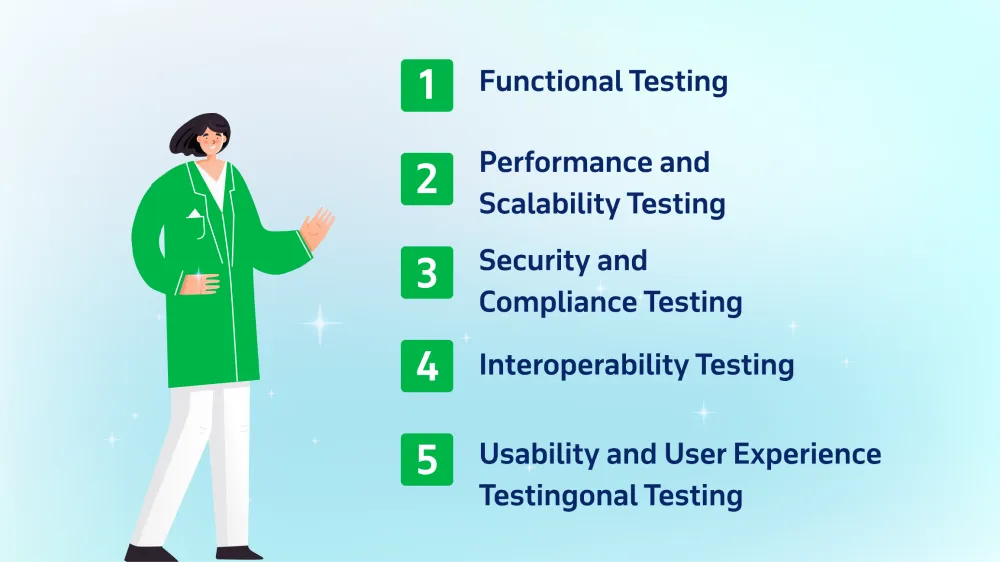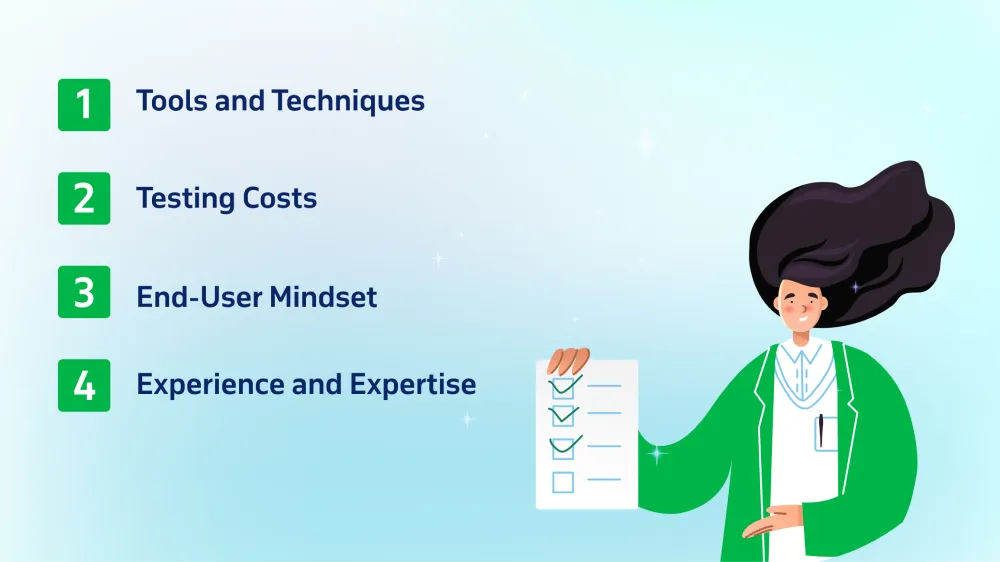The evolving healthcare software development sector earned nearly $600 billion last year, underscoring its significance in the industry. But big profits mean significant changes are on the horizon.
The demand for quality healthcare software development solutions is rising daily, and production failures are no longer acceptable in the healthcare business. Therefore, a thorough implementation of healthcare software testing strategies is required. Rigorous testing ensures patient safety and the proper functionality of software — but also contributes to a more efficient and reliable healthcare ecosystem.
We’d like to offer heathtech industry leaders some invaluable insights into software testing. This piece covers various testing types, step-by-step guidance for a well-defined healthcare software testing plan, and critical factors to consider when building a testing team.
What Is Healthcare Software Testing?
Healthcare software testing is necessary to verify and guarantee a software application’s quality, functionality, performance, and security. Tested applications can range from electronic health records (EHR) and telemedicine platforms to medical imaging systems and clinical decision-support tools.
It is testing healthcare software that ensures it meets the demands of the end-users, including patients, healthcare providers, insurers, regulators, and researchers. In addition, testing can validate compliance with relevant standards and regulations, such as HIPAA, FDA, GDPR, HL7, and DICOM, thereby safeguarding the security of patient data and healthcare institutions.
Types of Testing for Healthcare Software
Healthcare software testing processes involve assessing various perspectives of the final products. Therefore, acknowledging different types of testing is the key to developing the best testing plan. Some common types of healthcare software testing include:
- Functional testing
- Performance and scalability testing
- Security and compliance testing
- Interoperability testing
- Usability and user experience testing

1. Functional Testing
Functional testing involves evaluating healthcare software against specified requirements to verify that the new software solutions function as intended. Automation tools, like regression testing, are also leveraged in this testing type to significantly reduce testing costs and time.
By automating repetitive tasks and verifying that the new code won’t negatively impact existing functionality, healthcare software can maintain high quality, efficiency, and reliability standards.
2. Performance and Scalability Testing
Performance and scalability testing within the healthcare sector ensure the software can effectively meet care delivery demands. This testing guarantees smooth operation and reliable outcomes for medical professionals and patients.
Performance testing evaluates the software’s responsiveness under varying load conditions. For instance, reliability and speed are tested during peak hours in a hospital, when numerous healthcare providers access patient records simultaneously.
Meanwhile, scalability testing examines how well the software can handle the expanded scope of work, especially as healthcare networks expand to include new clinics or hospitals.
3. Security and Compliance Testing
Compliance testing is a critical shield safeguarding sensitive patient data and ensuring strict adherence to regulations within the healthcare sector. Specifically, healthcare software frequently manages Electronic Protected Health Information (ePHI), necessitating stringent safeguards outlined by HIPAA or GDPR.
The software is meticulously evaluated through compliance testing to verify its alignment with these mandated security standards. Moreover, testers will also examine the software’s security functionalities, focusing on access controls, data encryption, and audit controls to ensure comprehensive protection and regulatory compliance.
4. Interoperability Testing
In this form of healthcare software testing, test engineers ensure that a healthcare solution consistently shares medical data according to essential data transfer standards such as HL7, FHIR, and DICOM. The testing will concentrate on two primary areas: functional and technical interoperability.
Functional interoperability will involve engineers ensuring the accurate and complete exchange of data. Mainly, within this type of testing, the engineers can diligently confirm the receiving system’s correct interpretation of data from the originating system. The process will minimize the incidents of omissions or misinterpretations that may result in incorrect diagnoses or treatment errors.
Technical interoperability is a critical aspect of technical communication. Testers ensure the various systems use compatible data formats and industry-standard protocols. This field aims to identify any incompatible formats that can lead to data corruption or communication failures, hindering information exchange.
5. Usability and User Experience Testing
Usability and User Experience (UX) testing extends beyond routine functionality assessments. Usability testing mainly aims to evaluate the ease and effectiveness of users, such as doctors and patients, navigating and accomplishing tasks within healthcare software. Engineers analyze the intuitiveness of the interface and efficiency of workflows, with the goal of diminishing any likely errors that could compromise patient care.
Meanwhile, user experience testing focuses on user satisfaction with software. User-friendly interfaces empower patients to independently manage appointments, records, and prescriptions, encouraging proactiveness over fostering their health. Effective UX also supports streamlining care delivery, reducing stress for healthcare professionals, and improving treatment outcomes.
4 Steps to Design An Effective Healthcare Software Testing Plan
Developing a solid testing plan for healthcare software means thinking about the type of software (like EHR/EMR, HIS, telemedicine solutions, SaMD, etc.), how complex it is, what testing methods are needed, and the regulations it must follow (such as HIPAA in the US or GDPR in the EU). While plans can vary based on a solution’s features and testing methods, some key stages of any medical software testing project will involve:
- Software requirements analysis
- Test planning
- Test design
- Test execution and results reporting

1. Software Requirement Analysis
The software requirement analysis process is a strong foundation for any testing plan. To ensure drafting out a clear, complete, and most importantly, testable plan, healthcare organizations should:
- Scrutinizing Requirements: The analyst should meticulously examine the documented requirements to identify any ambiguities, inconsistencies, or missing details.
- Ensuring Testability: Each requirement has to be effectively tested. Unclear or immeasurable requirements need refinement to facilitate proper testing.
- Risk Identification and Mitigation: Identify potential risks associated with the project, such as resource limitations or unclear requirements. Formulate a plan to mitigate these risks and ensure project success.
2. Test Planning
Once they understand the roadmap, healthcare entities can plan the testing phase. The test plan is like a flowchart outlining the testing strategy and approach. A well-defined test plan typically includes:
- Testing Objectives: Clearly define testing process goals, including ensuring regulatory compliance or achieving specific functionality features.
- Testing Types: Outline different types of testing. Functionality, usability, and security testing are all part of an optimal testing plan.
- Testing Schedule: Draft a realistic timeline for each testing phase to ensure all essential timestamps are met.
- Resource Allocation: Identify the personnel required for testing, including their roles and responsibilities.
- Test Automation Strategy: Assess the feasibility of automation in test cases to improve efficiency and consistency.
- Testing Metrics: Define metrics for measuring testing effectiveness, such as defect rate or test case coverage.
3. Test Design
Test engineers begin the crucial test preparation stage using a comprehensive testing strategy. Some key steps involve:
- Preparing the Test Environment: Hardware and software setup is required to ensure compatibility and simulate the production environment. This also includes generating realistic test data and simulating the healthcare facility’s network infrastructure for software deployment.
- Crafting Test Scenarios and Cases: Test engineers will translate the testing strategy into actionable test cases. Typically, general scenarios are woven into specific test cases with user actions, expected system behavior, and assessment criteria.
- Assembling the Testing Toolkit: Effective communication and defect management is vital for successful testing. Test engineers ensure they have the necessary tools, including defect management tracking software and communication tools between stakeholders.
- Harnessing the Power of Automation (Optional): Automation can significantly improve repetitive or regression testing efficiency. Test engineers can leverage test automation tools and frameworks or write test automation scripts to mimic user actions and verify expected outcomes when feasible.
4. Test Execution And Results Reporting
The engineering team will execute the final phases when the test is fully designed. The engineering team will generate results from the healthcare software assessment. This stage of healthcare software testing typically entails the following:
- Executing and Maintaining Tests: This involves manual testing to identify issues like incorrect calculations, missing functionalities, or confusing user interfaces; otherwise, automation testing is an alternative.
- Defect Detection and Reporting: The engineer must catch any software bugs, glitches, or errors that could harm patients or hinder medical care. They should also document these defects clearly, including the steps to reproduce the issue and its potential impact.
- Validating Fixes and Regression Prevention: Once they address the defect, engineers re-run the test case(s) to confirm the issue is truly resolved. They also conduct broader testing to ensure new changes or fixes do not unintentionally introduce problems in other software functionalities.
- Communication and Reporting: Finally, the results of the testing efforts should be communicated through reports. These reports detail the number of tests conducted, defects found, and the overall progress of the testing process. KPIs should also get tracked, including defect detection rates, test case coverage, or time taken to resolve critical issues.
Factors To Consider When Building A Test Engineering Team
When it comes to conducting software testing, critical factors are taken into account. Specifically, to ensure the effectiveness and efficiency of the testing process, healthcare organizations should pay attention to:
- Tools and techniques
- Testing costs
- End-user mindset of testers
- Experience and expertise of testers

1. Tools and Techniques
When engaging in software testing, carefully selecting tools and techniques is paramount to ensuring optimal performance. Testing tools are crucial in streamlining test cases, data management, and report generation, while techniques empower testers to uncover latent defects that can impact product quality.
It is advisable to consider employing emerging methods such as cloud-based testing solutions, which enable teams to access virtual environments from any internet-connected location. These services provide cost-effective scalability, as they charge users based on usage, eliminating the need for significant investments in server hardware and reducing overall expenses.
2. Testing Costs
Healthcare software testing is crucial as it directly affects patient lives and well-being, but ensuring the quality and safety of such software can impact the bottom line.
The testing process handles a mass volume of data, requiring specific testing tools to verify encryption protocols and data integrity. These tools, however, are expensive to purchase or license. Moreover, test engineers with healthcare-specific knowledge are in high demand, leading to higher hiring costs than other general testers.
Even minor flaws in healthcare software can cause life-altering threats. Testing must be thorough and flawless. That may require more test cases, extended testing periods, and extra staff or tools. These steps can lead to a more complex and time-consuming process, inevitably increasing costs. The need to check and recheck systems and processes is why the expenses involved in this industry can make up a significant portion of the price, reaching up to 40% of software development costs.
3. End-User Mindset
One key to a successful software testing project is to choose testers who tailor their approach to the product and user base. They should think like end-users, go beyond scripted testing, and proactively suggest improvements to enhance user experience.
For instance, testers should thoroughly understand how busy doctors or non-tech patients will interact with the systems. That way, they can ensure the solution is intuitive and efficient in navigating a fast-paced healthcare environment.
4. Experience and Expertise
Healthcare software testing requires expertise in core testing methodologies and tools and working experience in the healthcare domain. This includes understanding medical terms, HIPAA regulations, and healthcare workflows for effective test case design. Experience with HL7, FHIR, and interoperability testing is also crucial to navigating various systems.
However, training testers in this case can be challenging due to the complex requirements and regulations imposed on healthcare software, which can incur costs and affect staffing quality. Besides, the ongoing economic downturn and prolonged staff burnout are hindering organizations’ financial and human resources capabilities and adding a layer of difficulty to ramping up a testing team.
Outsourcing to a reliable vendor can effectively address these concerns in such scenarios. The vendor assists healthcare organizations in reducing training and hiring expenses and provides the requisite expertise for a complex and repetitive testing process.
KMS Healthcare – Your Software Testing Partner of Excellence

The demand for reliable healthcare software, the growing complexities of business operations, and the emergence of new technologies are driving healthcare organizations to reject unmanaged testing practices. They rightfully require adopting more agile, well-defined, and all-encompassing testing plans before making any decision.
KMS Healthcare, with our 15-year presence in the healthtech sector, is more than familiar with most industry-standardized quality assurance and testing practices. We leverage market-leading frameworks and open-source tools to offer end-to-end testing services, including test management, test design, test execution, test automation, and test consultation with our global experts.

Let us help create testing solutions that optimize test coverage and accelerate time-to-market. Book a consultation now!